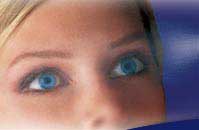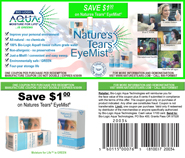
The Amazing Tear Film
Understanding Dry Eye
When the tear film loses moisture, it doesn't perform its many functions as well and vision can become compromised.
Exposed hard portions of the eye (including the white sclera and clear cornea), are protected and lubricated by the tear film, which also contributes to light refraction and supplies oxygen to living corneal cells. Though only 20 to 30 microns (millionths of a meter) thick, this multi-layered structure is amazingly complex. When the tear film loses moisture (water) due to illness or dehydrating environmental conditions, it doesn't perform these functions as well and eyes can become compromised. Dehydrated and irritated eyes (dry eye) mainly occurs as moisture loss in the tear film's middle (aqueous) layer.
Tear film layers.
Lipid layer. This outermost layer consists of a thin film of fatty oils (over 100 different fats and oils have been identified), that lubricate the eyelid, help protect the eye from airborne particles (dust, pollen, smoke, bacteria, etc.), and slow moisture evaporation from the aqueous layer.
Aqueous layer. The middle and by far the thickest tear film layer contains the vast majority of its moisture (water). It also contains electrolyte (salt), beneficial proteins and enzymes, and bacteria-fighting antibodies. Moisture loss from the aqueous layer can cause an over- concentration of salt that results in discomfort (usually burning). Note that perspiration also contains lipid, salt and water. Because tears contain much less salt than perspiration, when perspiration gets in the eye, the extra salt can also cause discomfort.
Also, since the cells of the cornea are live but contain no blood vessels, they depend on the aqueous layer's water for nutrition and oxygen. The water is most oxygenated when there is a steady inflow of humidity droplets, passing through the lipid layer, from the surrounding air.
Mucin layer. This bottom layer glues the tear film to the ocular surface.









